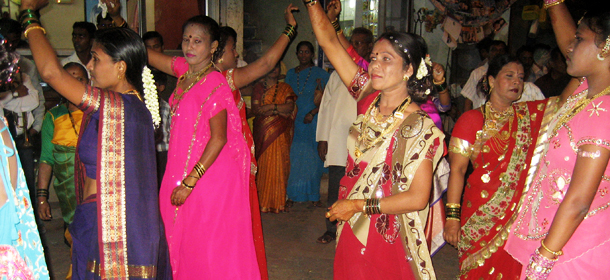Clothing and Culture: The Sari
Eintritt frei ARTE-Filmabend "Von Kopf bis Fuss" Weltkulturen Museum, Schaumainkai 29-37, 60594 Frankfurt
Bharati Giri draws a length of red fabric through the clean river water. To do so, this 24-year-old stewardess needs enormous strength, for the material is 6 m long and 1 m 10 wide. No easy undertaking a slender Indian woman. Today is washing day in Dharavi, a suburb of Mumbai/Bombay, and Bharati washes for the entire family: her mother, grandmother, sisters, and herself – there are seven saris in all. She uses no soap or suds. “These are very fine saris of silk,† explains Bharati. “They can't tolerate too many chemicals. Also, they are not worn directly against the body, but instead on top of a sort of slip or petticoat, so they don't have to be washed very often at all.† Over and over again, she draws the saris through the water, rubbing the material gently between her hands. She needs 15 minutes for each Sari. “I am fortunate to own a genuine silk sari. It was expensive, and absolutely must be properly cared for. For we Indians, the sari is a kind of national identity.† Although many Indians are poor and some are rich, and the Indian caste system stipulates which kind of sari a woman is allowed to wear and how, the sari is nonetheless India’s national costume. A sensual garment which enhances the beauty of the Indian woman, it also unites an entire people. Nearly all women here where a sari, only in the metropolis do we occasionally rarely women clad in western style attire. Long before sewn closing arrived in India, women wore this wrap style garment. Only fabric that remains untouched by a needle was regarded as “pure.† Saris are always brightly colorful. They are feasts for the eyes set against women's figures. They allow poverty to be forgotten, and give Indian women an atmosphere of joy in life. Saris are made from silk or cotton, chiffon, viscose or organza, and they measure between five and 9 m in length. They are either died or batiked, painted, stamped, or embroidered, and may be decorated with sequins or small pearls. Every Indian region can be distinguished by its typical colors, patterns, and motifs, and by its characteristic methods of weaving, painting, or printing. In this film, we make a clear distinction between the saris worn by the poor, and the silk saris in which the wealthy are wed. This garment, so captivating and beautiful, and such an enhancement to female beauty, is also a symbol of a caste system that leaves India stranded somewhere between tradition and modernity.



weltweiter Vertrieb: sky/Vision
Großbritannien
London
skyvision.sky.com
Screenplay/Direction
Susanne Brand
Produced:
2009,
ZDF/arte
45 min.
back to selection
